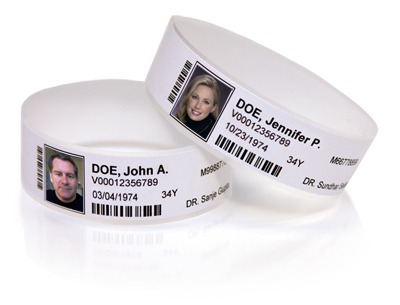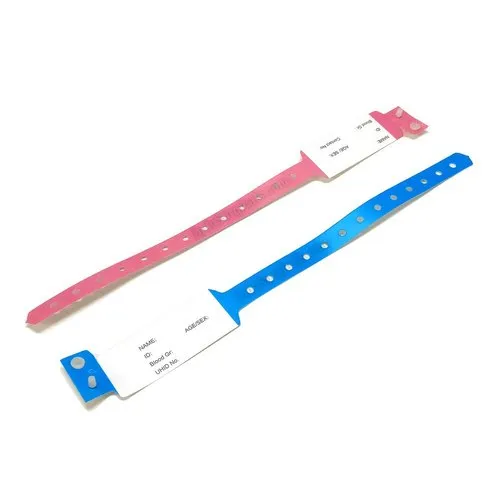Enhancing Safety: The Importance of Patient Identification Bands in Healthcare
In the world of health care, the efficacy of patient identification bands can not be overemphasized, as they work as a fundamental secure against misidentification and succeeding mistakes. These bands, frequently forgot, consist of important information that is essential for guaranteeing person safety and optimum therapy results. The execution of efficient identification methods postures several obstacles that health care suppliers must browse. As we explore the multifaceted role of these bands, it comes to be evident that their value prolongs beyond mere recognition, questioning concerning ideal methods and future advancements in patient safety and security.
Review of Client Identification Bands
Client identification bands play an essential duty in ensuring the safety and accuracy of individual treatment in health care settings. These bands, usually endured the wrist or ankle joint, work as a crucial tool for validating person identification, therefore decreasing the risk of mistakes in treatment, medication administration, and various other health care treatments. Made from resilient materials, person recognition bands often consist of important information such as the patient's name, date of birth, clinical document number, and barcodes or QR codes for scanning.
The implementation of individual identification bands is crucial in various health care atmospheres, consisting of health centers, outpatient centers, and long-lasting care organizations. They add to an organized technique in patient monitoring, allowing healthcare experts to rapidly and accurately identify individuals, especially in high-pressure circumstances where quick decision-making is important.
Furthermore, using these bands is straightened with regulatory standards aimed at boosting person safety - Patient Identification Band. By making sure that each person's info is conveniently proven and conveniently easily accessible, doctor can maintain a high standard of treatment, minimize the occurrence of negative events, and promote a culture of safety and security within medical care institutions
Advantages of Accurate Recognition
Precise recognition is basic to enhancing client security and care top quality in healthcare setups. It functions as the initial line of defense versus errors that could result in damaging individual end results. By making sure that each individual is correctly determined via dependable methods, such as individual identification bands, doctor can significantly minimize the risk of misidentification, which can lead to inappropriate treatments, drug mistakes, and also medical mix-ups.
In addition, exact patient recognition assists in effective communication amongst healthcare teams. When all team member can continually recognize individuals, they can share critical information much more efficiently, causing much better control of treatment. This is specifically essential in emergency circumstances where timely interventions are crucial.
Additionally, precise recognition supports compliance with governing criteria, thus reducing the threat of legal consequences for healthcare centers. It cultivates count on between people and medical care companies, as individuals feel a lot more secure understanding that their identities are being protected.

Usual Difficulties Encountered
Making certain efficient individual recognition in health care settings presents a range of challenges that can jeopardize security and care quality. Individuals may get here in a state of complication or distress, making precise recognition difficult.
An additional difficulty is the reliance on human consider identification procedures. Healthcare experts may unintentionally overlook or misinterpret identification procedures, particularly in high-stress settings such as emergency divisions. This can result in errors, including the administration of incorrect treatments or medicines.
Technical issues likewise posture challenges. Although digital health record (EHR) systems are designed to enhance client recognition, system blackouts or individual errors can interfere with the procedure. Additionally, the physical design of person ID bands can bring about readability issues, particularly in instances where bands are damaged or covered.
Lastly, inconsistent training amongst personnel relating to identification protocols can result in gaps in expertise and technique. Dealing with these challenges is important for enhancing individual safety and ensuring that identification bands serve their designated purpose effectively.
Ideal Practices for Application
To effectively implement client recognition bands in health care settings, companies should take on a multifaceted approach that focuses on standardization, modern technology, and training integration. Standardization entails developing clear procedures for the design, application, and use identification bands throughout all departments. This makes certain consistency and decreases the danger of mistakes linked to differences in band types or classifying methods.


Training is essential for all medical care personnel to ensure they recognize the value of accurate patient recognition, how to properly use and read recognition bands, and the procedures to follow in instance of inconsistencies. Regular workshops and refresher course courses can enhance this understanding and promote a culture of safety.
Modern technology assimilation plays an essential function in improving the efficiency of Visit Website person identification bands. Utilizing barcode scanning or RFID modern technology can simplify the recognition procedure, enabling real-time confirmation of patient identifications. In addition, electronic wellness record systems need to be configured to consist of alerts for mismatches in between the identification band and client information.
Future Trends in Patient Security
As medical care remains to progress, the focus on patient security is most likely to increase, driven by advancements in innovation and a better understanding of systemic risks. Emerging patterns show a change see this towards more integrated systems that take advantage of information analytics, expert system, and artificial intelligence to enhance patient identification procedures. These modern technologies can assist determine possible safety and security concerns prior to they escalate, thereby decreasing mistakes connected with misidentification.
In addition, the execution of blockchain technology may revolutionize how patient information is safely shared amongst medical care service providers, making sure that recognition bands are regularly exact and current. This will certainly not only enhance patient safety but additionally promote smooth interaction across multidisciplinary teams.

Furthermore, the growing concentrate on tailored medicine is expected to influence individual safety and security protocols. By incorporating group and hereditary information into identification systems, health care specialists can customize treatments better, lessening the threats of damaging responses due to misidentification.
Conclusion
In final thought, person recognition bands offer as a crucial part in enhancing safety within healthcare settings. Inevitably, the continued focus on robust recognition procedures will certainly contribute to enhanced individual outcomes and general safety in health care setups.
In the world of medical care, the efficacy of individual identification bands can not be overemphasized, as they serve as a basic secure against misidentification his explanation and succeeding errors.Individual identification bands play an essential duty in making certain the safety and precision of client treatment in healthcare setups. Made from durable materials, person identification bands usually include crucial information such as the individual's name, date of birth, medical document number, and barcodes or QR codes for scanning.
By ensuring that each individual is properly determined via reputable methods, such as client recognition bands, medical care companies can dramatically reduce the danger of misidentification, which can lead to unacceptable treatments, medicine mistakes, and also medical mix-ups.
In conclusion, client recognition bands offer as an essential component in improving security within medical care settings. Patient Identification Band.